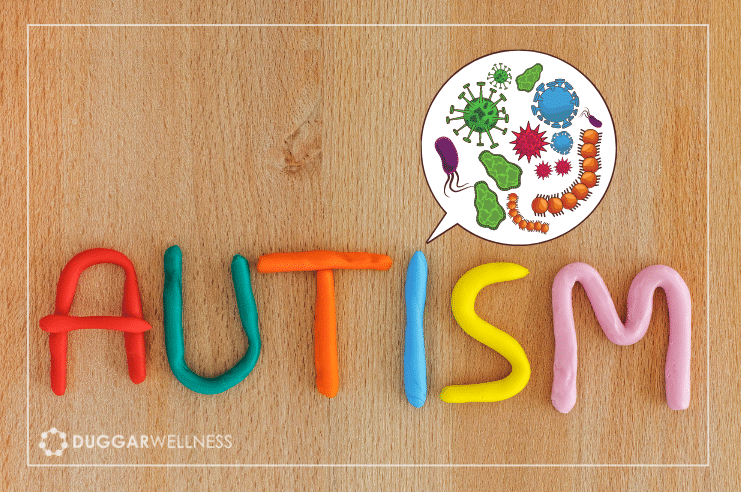I heard a sobering prediction that if current trends continue, by the year 2030, 1 in 2 school-aged children will be on the Autism Spectrum. What??? We’ve gone from 1 in 150 children in 2000 (already a crazy high number) to 1 in 2 children in less than 30 years. While there are some pretty strong genetic implications, there is no way that an epidemic like this can be attributed to genetic mutation. So what is going on?
Undoubtedly, there are many factors at play in the development of this spectrum of brain disorders. Some try to brush it all off by saying that it is just due to better and earlier diagnosis but there is no way that could account for the numbers were now seeing filling up our schools and care facilities.
One of the most fascinating areas of research has to do with the relationship of the “environment” of the digestive tract, or what is called the “gut microbiome”.
According to a paper published in the journal Current Psychiatry Reports in February 2013, entitled The Gut Microbiome: New Frontiers in Autism Research, there is a powerful relationship between the types and amounts of healthy bacteria in our gut and how our brains develop and function.
As a backdrop to this discussion, it might be a good reminder that we coexist with immense populations of microbial species. It has been estimated that up to 100 trillion microbial cells make a home on and inside of us. These microbes outnumber human body cells 10 to 1, leading some to term the human microbiome our “second genome”. In a very real sense, there is 150 times more genetic material in our body that isn’t human than there is human. And it turns out these bacteria are hard at work, impacting our health in profound ways.
Most of the initial research on the gut flora has been done on adults but the research on children has been pivotal in our understanding of how the gut microbiome is established. It turns out that prior to birth, our guts are sterile and pristine but during the birth process itself we receive our first exposure to the bacteria that will eventually colonize the gut. Science has shown that vaginal delivery inoculates the baby with different strains of bacteria than C-section delivery, with the former being a more normal gut friendly variety. In addition, breast-feeding vs. bottle feeding has a profound impact on the development of normal colonies of bacteria. Introduction of solid foods, antibiotic exposure in infancy and the general state of the home environment as a child grows impacts the baby’s microbiome. By the time a child is 3 years old, they have established a robust “adult” level of microflora.
So what is the role of the microflora?
Do these colonies have an impact on health and disease? It seems that they do exert a profound and critically important role that we had better pay attention to if we want to be healthy.
1. Nutrient digestion – One of the primary roles of the gut microbiome is to help us digest food. In fact, as humans we lack the right enzymes necessary to digest many plant nutrients. It is only through the functions of the flora that we are able to break them down and assimilate the nutrients contained in them. Estimates are that up to 10% of available caloric intake in a western diet come from bacterial digestion. Pretty fascinating don’t you think?
2. Immune health. Another area where the microbial world impacts our health is in the realm of immunological development. It seems that without the friendly bacteria present in our guts, our immune systems don’t develop properly. Through mechanisms that we are not even close to numbering, it appears that our immune systems have to be presented with friendly bacteria before they can learn to distinguish the unfriendly kinds. An amazing 80% of our entire immune system lines our GI tract and there is a complex dance taking place between our immune system and the bacteria present there.
3. Disease development. When the gut microflora doesn’t develop normally, is wiped out by antibiotics or other medications or gets overrun by harmful bacteria, yeasts or parasites, it can lead to disease states as far ranging as heart disease and obesity. In autistic children researchers have identified significant alteration of gut microflora from healthy children. One of the characteristics of autism is an alteration in the child’s eating habits. Food selectivity (only wanting certain types of food) is a very common symptom in ASD, with children almost always preferring starches, grains and other high carbohydrate foods. We know that non-diverse diets create a non-healthy microflora concentrations. Whether the altered diets are causing the microflora to be out of balance or the bacteria are causing the food selectivity has not been completely determined as of yet but we know that influencing the gut flora in these children often changes their behavior and neurological function.
While there are many more questions than answers right now, the research is beginning to lay out some possible mechanisms for the role of the gut in the spectrum of autistic disorders.
Clinically, we have seen significant improvements in children who have been diagnosed with ASD by initiating a gut healing protocol aimed at restoring normal gut flora and increasing nutrient absorption and we are excited to see where this arm of research leads in the coming years.
Heaven knows we need some answers, quick.
 160 N Main, Bountiful, UT 84010
160 N Main, Bountiful, UT 84010  801-677-7878
801-677-7878


One response to “Autism and Gut Microflora”
[…] we see in the clinic. I’ve posted on gut related issues a couple of times before (like here and here). What may be surprising to some though is just how often even those without obvious […]